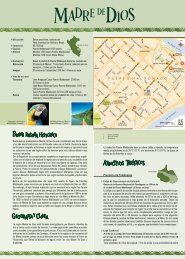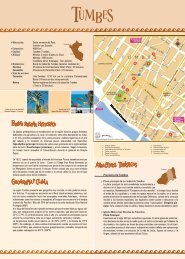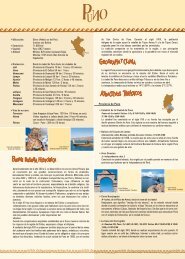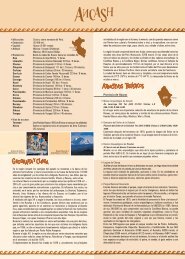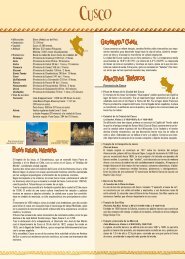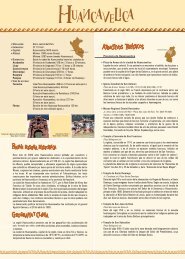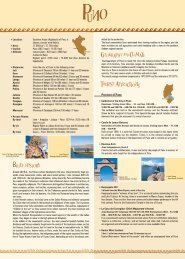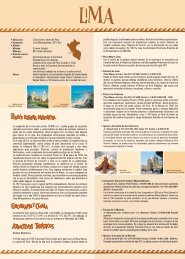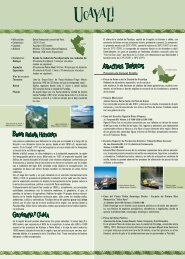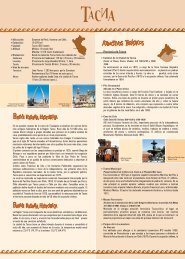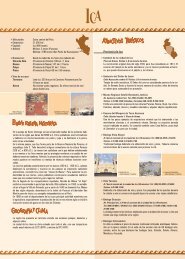Province of Chachapoyas - South American Destination
Province of Chachapoyas - South American Destination
Province of Chachapoyas - South American Destination
Create successful ePaper yourself
Turn your PDF publications into a flip-book with our unique Google optimized e-Paper software.
Pozo de Yanayacu (Yanayacu Well)<br />
Located on the hill, Cerro Luya Urco, 1 km from the Main Square (15 minutes on foot)<br />
The original name <strong>of</strong> the well was “Fuente Cuyana” (Cuyana Springs) and according<br />
to tradition, single men that arrived in the city and drank its waters remained<br />
forever, attracted by the irresistible charm <strong>of</strong> its beautiful women. Saint Toribio de<br />
Mogrovejo came to this place and, on a rock, sculpted the figures <strong>of</strong> a miter and a<br />
crosier, and the year.<br />
Yalape Archeological Remains<br />
21 km / 13 miles south <strong>of</strong> <strong>Chachapoyas</strong> (40 minutes by car)<br />
Located at 2700 masl / 8858 fasl, this Chachapoya archeological complex dates<br />
back to 1100 to 1300 A.D. The area is calculated to be four hectares and features<br />
the classic circular constructions decorated with rhomboidal and zigzag friezes in<br />
high relief.<br />
Iglesia de Jalca<br />
Mylene D'Auriol / PromPerú<br />
Laguna de los Cóndores (Lake <strong>of</strong> the Condors)<br />
93 km / 58 miles south <strong>of</strong> <strong>Chachapoyas</strong> (3 hours and 30 minutes by car) is the town <strong>of</strong><br />
Leymebamba. From there, it is another 45 km / 28 miles to the lake (12 hours on foot<br />
and by mule). You will need to hire a guide.<br />
It is also known as the Laguna de las Momias (Lake <strong>of</strong> the Mummies) since more<br />
than 200 mummies were found embedded on the side <strong>of</strong> a cliff located on its<br />
shores, all in good condition despite the hot and humid climate <strong>of</strong> the area. Along<br />
with the mummies around 3000 objects belonging to the Chachapoya and Incan cultures<br />
were found. The caves are decorated with prehistoric rock paintings<br />
Leymebamba Site Museum<br />
Avenida Austria, Leymebamba. Visiting hours: Mon. – Sun. 9:30 A.M. – 4:30 P.M.<br />
The city <strong>of</strong> Leymebamba is 93 km / 58 miles south <strong>of</strong> <strong>Chachapoyas</strong> (3 hours and 30<br />
minutes by car). The museum is a 10 km / 6 miles walk from the city.<br />
This modern museum exhibits the mummies and the objects found at the Lake <strong>of</strong><br />
the Condors as well as textiles, ceramics, and weapons found in the area.<br />
<strong>Province</strong> <strong>of</strong> Bagua<br />
Numparket Waterfall<br />
40 km / 25 miles north <strong>of</strong> Bagua (3 hours by car and another 3<br />
hours by mule)<br />
This beautiful waterfall <strong>of</strong> some 90 meters / 295 feet<br />
descends into a 20 m 2 / 215 feet 2 pool..<br />
Pongo de Rentema(Rentama Narrows)<br />
Take the Jaen-Bagua highway to gain access, 14 km / 9 miles from Bagua (40 minutes)<br />
The narrows runs parallel to the Bagua-Imazita highway and is 2 km / 1,2 miles<br />
wide at its widest point. Nearby, the Marañon, Utcubamba, and Chinchipe rivers<br />
merge together.<br />
<strong>Province</strong> <strong>of</strong> Bongará<br />
Niño en fortaleza de Kuélap<br />
Mylene D'Auriol / PromPerú<br />
Laguna de Pomacochas (Lake Pomacochas)<br />
You arrive at the town <strong>of</strong> Pomacochas, 84 km / 52 miles north<br />
<strong>of</strong> <strong>Chachapoyas</strong> (3 hours by car). From there, a 1 km / 0,6 miles<br />
walk brings you to the lake (15 minutes on foot).<br />
The mere is 2858 meters / 9377 feet long, 2440 meters /<br />
8005 feet wide, and located at 2150 masl / 7054 fasl. It is fed by subterranean<br />
waters, and the color is dark green at its deepest location (80 meters / 262 feet).<br />
The surrounding flora includes totora reeds, yedra bells, and fox tails. Among the<br />
representative animals are herons and grebes.<br />
Chinata Waterfall<br />
7 km / 4 miles away from the town <strong>of</strong> Pedro Ruiz Gallo, you will arrive at the District <strong>of</strong><br />
San Carlos (20 minutes by car). From there, a 12 km / 7 miles walk takes you to the waterfall<br />
(2 hours).<br />
This waterfall is approximately 580 meters / 1903 feet, and its name means<br />
“Spring that falls from heaven”. Abundant vegetation grows all around it, typical <strong>of</strong><br />
the rim <strong>of</strong> the jungle, mostly orchids, ferns, and moss.<br />
<strong>Province</strong> <strong>of</strong> Luya<br />
Catarata y Aguas Termales de Corontachaca<br />
(Corontachaca Waterfall and Hot Springs)<br />
5 km / 3 miles from Pedro Ruiz Gallo (10 minutes by car)<br />
This is an 80 meter / 262 feet waterfall. One side has formed<br />
a small hot spring <strong>of</strong> salt and sulfuric water. Two flows <strong>of</strong><br />
heated water fall from the rocks at a rate <strong>of</strong> 2 liters per minute.<br />
Fortaleza Fortress<br />
72 km / 45 miles southeast <strong>of</strong> <strong>Chachapoyas</strong> (3 hours and 30 minutes by 4x4 vehicle)<br />
This impressive stone fortress was built by the Chachapoya people around 800<br />
A.D. It is located 3000 masl / 9843 fasl and is 6 hectares in surface. There are<br />
three defensive platforms; the first is 20 meters / 66 feet high and 680 meters /<br />
2231 feet long. Its three entrances are walled alley-ways that narrow as they climb<br />
up to the following two platforms. Inside, there are 420 circular buildin.<br />
Karajia Sarcophagi<br />
48 km / 30 miles northeast <strong>of</strong> <strong>Chachapoyas</strong> (2 hours by car and another 20 minutes on<br />
foot)<br />
These c<strong>of</strong>fins are pre-Inca tombs, some 1000 years old, implanted at the top <strong>of</strong> a<br />
cliff. They are 2 meters / 7 feet tall, sculpted in mud, and are decorated with geometric<br />
motives. They probably served to house the remains <strong>of</strong> the supreme tribal<br />
leaders.<br />
The most important dances <strong>of</strong> the department are the Chumaichada (an urban<br />
dance), the Levanto dance, the Anchashkenken, the Trenzas, the Chuquiac, the<br />
Carnaval de <strong>Chachapoyas</strong> dance, and the El Brazo dance.<br />
The following list highlights some typical dishes <strong>of</strong> Amazonas:<br />
Purtumute: Boiled beans with mote sancochado (individual grains <strong>of</strong> corn boiled<br />
with cilantro)<br />
Cuy con papas: Seasoned, cooked, and fried Guinea pig served with a potato stew,<br />
toasted peanuts, chopped onions and hot peppers.<br />
Juanes de yuca: Grated and boiled yucca mixed with rice and either chicken or<br />
beef jerky; this mixture is wrapped in a banana leaf and steamed.<br />
Cecina: Beef or pork jerky<br />
Tamales: Mashed corn filled with beef, wrapped in banana leaves, and steamed.<br />
Humitas: Mashed corn filled with seasoned beef or cheese, wrapped in corn<br />
shucks and steamed.<br />
Enrollado: Roast beef, rolled and stuffed with ground pork and chicken meat,<br />
raisins, and hard boiled egg.<br />
Traditional drinks<br />
Guarapo: drink made from boiled and fermented sugar cane juice.<br />
Chuchuhuasi: cordial made from a bitter root <strong>of</strong> the same name; very popular<br />
everywhere in eastern Peru but found only in the <strong>Province</strong> <strong>of</strong> Condorcanqui.<br />
Licor de mora: made from cordial, blackberries, and syrup.<br />
Licor de leche: made from cordial and whey filtered drop by drop until transparent.<br />
Pur Pur: made from cordial, fruit and pur pur seeds. Later, syrup is added.<br />
Chachapoyan Carnival – February – March<br />
<strong>Province</strong> <strong>of</strong> <strong>Chachapoyas</strong><br />
It is a mixture <strong>of</strong> Celendinas and Chachapoyan customs. It is celebrated with the<br />
planting <strong>of</strong> “Humishas”, large trees decorated with balloons, streamers, clothing,<br />
and other objects. In addition, there is a float contest, a carnival queen election,<br />
social and popular dancing, and games with water, streamers, and colors



